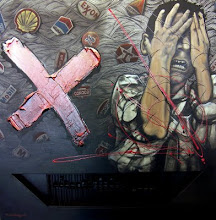Hasta mediados del siglo XX, el arte era una herramienta simbólica, un medio para transgredir su definición, los modos de representación y su función. Con el arte se cuestionaba la realidad estimulando el advenimiento de una nueva sociedad, un arte propositivo de transformación. Pero el arte comenzó a adquirir otro papel después de la II Guerra Mundial. La sociedad post-industrial asimila la vanguardia y su papel trasgresor manipulada por el intervencionismo del estado en las sociedades industrializadas occidentales. A comienzos de los setentas se implantan los canales por los que el arte se distribuirá en adelante. Galerías de arte y museos se convierten en definitivos legitimadores que propugnan el arte como mercancía. Desde los ochenta, el arte es esencialmente un bien de consumo, trastocándose profundamente su peso simbólico al enfatizar su carácter de mercancía.
To the middle of the 20th century, the art was a symbolic tool, a source to infringe its definition, the ways of representation and its function. With the art the reality stimulating was questioned the arrival of a new society, an proposal art of transformation. But the art began to acquire another role after the II World War. The post-industrial society assimilates the vanguard and its role transgressor manipulated by the interventionism of the state in the industrialized westerners societies. At the beginning of the seventies the channels by the ones are established the art will be distributed on. Galleries of art and museums become final validate and support the art as merchandise. Since the eighties, the art is essentially a well of consumption, changing deeply its symbolic meaning to emphasize its character of merchandise.

